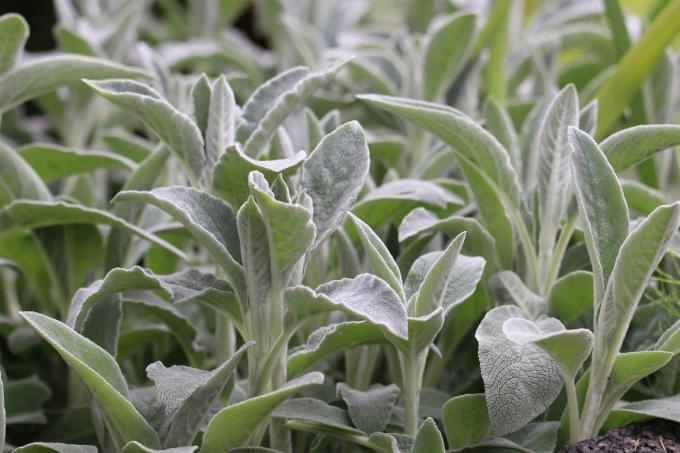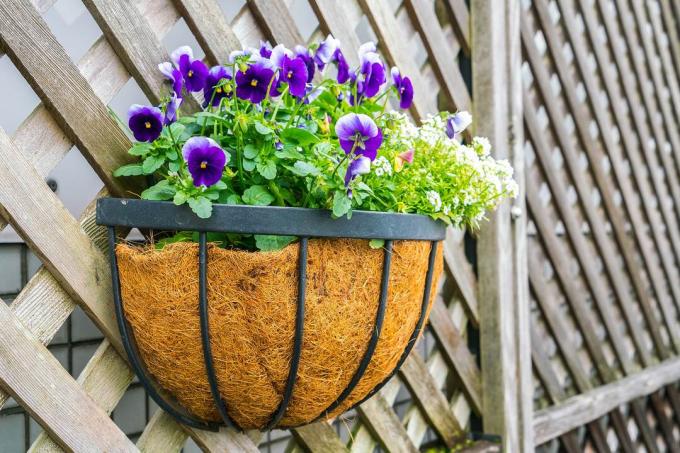
Planting makes a garden fence more attractive. Here you will find a selection of ideas for planting options that make every fence an eye-catcher and beautify the garden as a whole.
In a nutshell
- Garden fence planting as privacy and wind protection
- Perennials usually only suitable for summer planting
- Combinations of different plant species for a varied look
Table of contents
- Plant garden fence
- Hedge planting as privacy and wind protection
- Fence design with tendrils
- Ornamental grasses for a special flair
- Sea of flowers with perennials
- herb bed
- Ground cover for fence underlining
- flower boxes and baskets
- frequently asked Questions
Plant garden fence
There are many reasons why garden owners want to green their fence. Be it for aesthetic reasons, for reasons of space or as a privacy measure. There are many plants that are suitable for such a planting. However, the site conditions, the growth width and the growth height should be considered before planting.

Hedge planting as privacy and wind protection
Numerous garden owners want plants in front of their garden fence that provide privacy from prying eyes from neighbors or passers-by or protect them from the wind. But unsightly garden fences can also be intelligently hidden behind dense hedges.
Among the most popular hedge plants for a garden fence planting, fast-growing ones count, because they can restrict the field of view of the property from the second year. They can usually be kept or cut to any desired height. Only one type of plant should be chosen as a hedge to ensure a uniform and well-groomed overall appearance.
Below is a small selection of pruning-tolerant and fast-growing hedge plants:
- Cherry laurel (Prunus laurocerasus)
- tree of life (thuja)
- Privet 'Atrovirens' (Ligustrum vulgare 'Atrovirens')

A notice: Because cherry laurel reacts sensitively to wind, especially in the first few years of life, it feels particularly comfortable in front of closed fences, such as gabions or other types of sealing fences.
Fence design with tendrils
Climbing plants are an optimal choice for planting a garden fence, which is to be decoratively covered. Vines require regular pruning to encourage dense growth and bud formation. Depending on the type of fence and type of plant is also one climbing aid to mount.
Flowering climbing plants are particularly decorative. They give garden fences a romantic, dreamy charm and quickly hide unsightly fences under their leaves. In addition, with the appropriate climbing base, they rise far into the air and grow very densely, so that they can also act as privacy and wind protection for numerous climbing plants.

Particularly decorative climbing plants are:
- Clematis (Clematis)
- Honeysuckle (Lonicera)
- Common ivy (Hedera helix)
- climbing roses (Pink)
Tip: For year round Privacy and wind protection the evergreen clematis (Clematis armandii) is an excellent choice. If you want to benefit from a second flowering period, you should take a closer look at the clematis variety 'Multi Blue'.
Ornamental grasses for a special flair
ornamental grasses are very popular as fence plants because they spread a sea feeling and sway elegantly in the wind. They are usually easy to care for and, depending on the variety, also offer stylish privacy protection. Some are deciduous, others winter or evergreen. They are particularly evident when there are flowering plants of different growth heights between them.

The TOP ornamental grasses that underpin every fence with a "refreshing" atmosphere include these:
- Chinese reed (Miscanthus)
- Pennisetum (Pennisetum)
- pampas grass (Cortaderia selloana)
Sea of flowers with perennials
Perennials are an ideal plant choice for fence owners who like colorful blooms and prefer insect-friendly plants. They look particularly good in front of wooden fences because they create an idyllic, harmonious and natural overall picture. However, most perennials are only attractive during the gardening season and leave large gaps in the fence planting in winter. So that it also looks decorative in front of the garden fence in winter, you should alternate with evergreen plants like for example boxwood (Buxus) or winter jasmine (Jasminum nudiflorum) can be planted.

Flowering perennials with long flowering times include:
- Agastache (Scented Nettle)
- Catnip (Nepeta cataria)
- sunflowers (helianthus)
herb bed
A herb bed placed in front of it goes particularly well with wooden fences. A pleasant scent emanates from these. There are numerous types of herbs that are hardy and evergreen. Especially during the gardening season, many specimens bloom lavishly and set different color accents. It is advisable to place them on the garden/property side so that nobody uses the herbs without authorization. These types of herbs are extremely popular and decorative for planting on a garden fence, and they all also feel at home in planters and baskets.

Here some examples:
- savory (Satureja)
- Southernwood (Artemisia abrotanum)
- Holy herb (Santolina)
- Lavender (Lavandula angustifolia)
- rosemary (Salvia rosmarinus)
- Hyssop (Hyssopus officinalis)
Ground cover for fence underlining
Ground covers are an ideal choice if you want to emphasize the garden fence look. They are unobtrusive and still give garden fences, which are pretty to look at, the space to expressively stand out. At the same time, ground covers help to restrict weed growth. In addition, they are very easy to care for and can be easily shortened with hedge trimmers if necessary.

Among the most popular ground covers, which look good in front of a fence and also cope well with heat build-up include:
- Cushion silver rhombus (Artemisia schmidtiana 'Nana')
- Prickly Nuts (Acaena buchananii)
- Wollziest (Stachys byzantina)
flower boxes and baskets
Flower boxes and baskets offer a lot of flexibility in the fence design with plants. You can do this every year new plants used depending on mood, taste and needs. Plant mixes that consist of different colors and harmonize with each other are ideal. The flower boxes or baskets can be offset on several levels or hung next to each other - depending on your taste. You can fill the whole garden fence with a sea of flowers. In addition, a few wall decoration items attached to the garden fence give it liveliness and gain expression.

Tip: flower boxes You can also easily make your own out of wood.
Suitable specimens can be found among the balcony plants, such as:
- Verbena (verbs)
- Geraniums (Pelargonium zonale)
- Lantana (Lantana)
- Magic bells (Calibrachoa)
frequently asked Questions
The light and air conditions that can be influenced by a fence are important. Not only the orientation plays a role, but also the type of fence. If the fence is closed and permeable to air, heat can build up, severely drying out the soil and burning plants. An airy location or a sufficiently large distance from the fence is advisable.
This depends above all on the expected plant width and the plant species. Climbing plants can be placed on the garden fence according to the regular, recommended planting distance information. More heat-sensitive plants should have at least 20 centimeters of air space to the garden fence when fully grown. For hedges, the recommended planting distance should also be observed, which you should increase to open garden fences if you don't want them to grow through too much.
It is important to pay attention to the type of climbing in relation to the type of fence, so that there is support and the possibility of climbing. Purely climbing plants, such as clematis, need thin lattice-like or fine-meshed fence constructions. Self-climbing, heavy plants like ivy need sturdy fences. Spreading climbers, such as climbing roses, also require stable, resilient fences and horizontal cross braces to hold on to. Climbing plants, like honeysuckle, should be placed in front of medium to sturdy fences with thin sections of wire.



